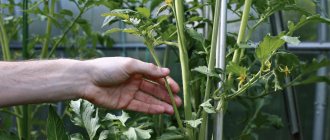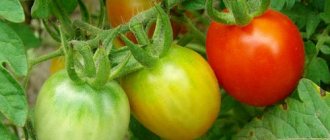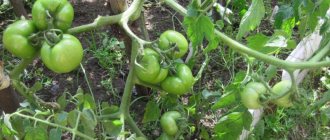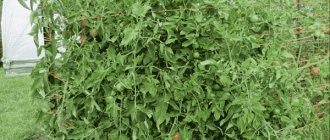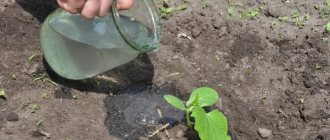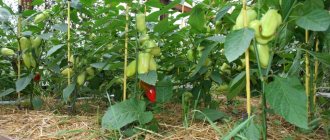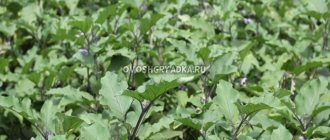The nuances of sowing tomatoes in a greenhouse before winter
Planting tomatoes as seedlings and then planting them in beds in the garden is a familiar procedure for many gardeners.
But some people don’t want to waste time and effort on growing seedlings, preferring to sow tomatoes in a greenhouse before winter and as a result get good seedlings and a stable harvest. The greenhouse is made of different materials. This can be a permanent building with a heating system, or a metal frame structure with polycarbonate and glass. Polycarbonate reduces heating costs because it maintains the room temperature, similar to a thermos. The dimensions of a private greenhouse are from 100 to 500 m2, industrial - about 1000 m2.
The main advantages of winter planting
Beginning farmers often have doubts about the advisability of sowing tomatoes in a greenhouse before winter, but this method has many advantages:
- In winter, tomatoes are hardened in the greenhouse, so they are not afraid of diseases such as late blight.
- There is no need for pre-soaking seeds, treatment with growth stimulants and fungicides.
- Melt water will allow the seeds to adapt and become a natural growth stimulator.
- Shoots will appear when the right time comes, and often winter seedlings hatch much faster than those grown using standard technology.
- The bushes will turn out healthy and strong, with developed roots. No picking required.
- The harvest from winter tomatoes is greater, even in dry summer conditions.
- Time and energy are saved, and in the spring they can be spent on other things.
Several methods for autumn planting
Fans of experiments have tried several options for winter planting tomatoes. And they recognized that they are all similar, but each has its own characteristics .
READ ALSO: Allium Decorative onion
Whole tomatoes
This method is the easiest. It is good for experience so that you can decide in the future whether to adopt this method. When the first light frost sets in, dig a hole a few centimeters deep, put a ripe tomato in it and cover it with soil. Build a “coat” of spruce branches and dry leaves or compost on top. With the onset of spring warmth, the shelter must be removed. The seedlings will emerge to the surface in a whole bunch. When they grow a little, they should be planted in a permanent place.
Winter tomatoes in straw
For autumn planting, you need to select ripe fruits from productive healthy bushes in advance and put them in storage until the end of October - beginning of November. With the arrival of the first frosty days, dig holes approximately 15 cm deep. Place rotted straw and one tomato at the bottom of each. Then fill the holes with straw and insulate them with a thick layer of mulch.
When the snow melts, the holes must be protected from returning cold with covering material. A few days after this operation, groups of sprouts will sprout - from 7 to 25 from each planted tomato. When they get stronger, they need to be transplanted into a greenhouse or open ground to a permanent place.
Sowing dry seeds
You can sow in one of two ways: in grooves 1-2 cm deep or in heaps every 15 cm. Cover the top with spruce branches or mowed green manure. Only the healthiest ones will germinate from these seeds, so there is no need to maintain any distance between seeds. After sowing, be sure to mark the planting site so that you don’t have to look for it in the spring. As soon as the first spring warmth arrives, the bed should be cleared to give freedom to seedlings.
Considering that the seeds underwent natural stratification during the winter months, they will germinate very well. The seedlings will be stocky, hardened and will not need means to combat diseases and insect pests.
Pre-winter sowing differs from traditional sowing. Therefore, the gardener must:
- know the rules for winter sowing of seeds;
- replace or disinfect the top layer of soil with a weak solution of potassium permanganate;
- Do not put off greenhouse repairs until spring; they need to be done before the onset of frost.
For your information: winter tomato seedlings are initially inferior in growth to home seedlings, but within a month they catch up with them. And then the seedlings’ ability to resist diseases and pests is revealed.
Step-by-step soil preparation in a greenhouse
When planning winter sowing of tomatoes, it is important to create suitable conditions. Work begins a month before planting the seedlings. In the summer, insects and bacteria accumulate in the greenhouse, so it is necessary to treat the frame, shelving and all accessories, as well as equipment and soil. Using a shovel, you can remove a 30 cm layer of soil and replace it with turf soil. Hay and leaves, ash or lowland peat, as well as green manure are laid under it. In such soil, the plants will take root well over the winter, and thanks to fertilizing, they will prepare for abundant fruiting.
Next, the soil is fertilized with granulated superphosphate, chicken or rabbit droppings. The turf soil is sifted to get rid of pest larvae. You can use the drugs Nematophagin and Batolin-T.
Pre-winter sowing of tomatoes for compost
When making compost at home, when using kitchen waste, you can notice that seeds from rotten tomatoes germinate intensively even where it is not needed. This vitality of tomato seeds can be used for your own purposes in order to grow magnificent seedlings right in the compost pit by spring. It’s good when the farm has a pit with compost, but even if it doesn’t, it will be possible to allocate an area of 1 cubic meter on the plot and dump a bucket of compost on it.
The agricultural technology for winter planting on compost is very simple: you don’t even need special holes, you just need to spread whole tomatoes over a prepared bed and cover them with branches or lightly sprinkle them with soil. Over the winter, the tomatoes will rot and the seeds will end up in the compost. After spring arrives and the snow melts, a small bed can also be placed under cover to protect the sprouts from the spring night cold. As soon as the seedlings acquire their first leaves, they can be planted with compost, first in a temporary indoor nursery, and then together with the rest of the seedlings in the open air.
There is no doubt that sowing tomatoes in winter is a good solution for temperate climates. But experienced gardeners do not recommend completely switching to this method right away. It will be possible to divide the planting, for example, grow half of the seedlings as usual, on the windowsill, and try to grow the other part using the proposed methods. This will make it possible to adapt winter crops to your climate and avoid possible risks of losing the entire tomato harvest. It is also important to use only pure tomato varieties, because sowing hybrid ones may not meet yield expectations.
Features of pre-winter planting and cultivation
Sowing tomatoes before winter in a greenhouse is done in the ground or planted with seedlings that have grown on racks if the beds are occupied by other crops. For planting in a greenhouse, disposable dishes or cassettes are used. Seeds for seedlings are sown 45–55 days before being placed in the greenhouse.
Growing crops in winter is a profitable business, since the average harvest from 1 bush is 6000–7000 g of product. How to use and to whom to sell the harvest is another question. You can sell it to wholesalers, start canning, or open a retail outlet. In any case, there will be profit. The main condition is to take into account the recommendations regarding winter sowing of tomatoes and ensure proper conditions in the greenhouse.
Exotic way
Throw soured pickled tomatoes (not canned) onto a compost heap or into humus. In early spring, compost is scattered around the site as organic fertilizer. It is likely that the tomatoes will sprout even with such careless planting.
Women's jeans: before you buy them, you need to pay attention to one detail
“We are still friends”: Derevianko commented on the breakup with his wife
It’s good to wash often: myths about shampoo and hair care that only harm
Transplantation into a greenhouse and subsequent care
To sow tomatoes before winter, you need strong seedlings 2 months old. Planting is carried out in 2 rows in a checkerboard pattern. 4 bushes should fit per 1 m2. The recommended distance between sprouts is 35 cm, between adjacent rows is 50 cm, and 1 m of space is left before the next double row.
Seedlings are planted by transshipment, deepening the plant into the soil up to the cotyledon leaves. Each sprout is tied to a crossbar or tensioned wire at the top of the greenhouse using twine. As the top of the bush rises by 10 cm, it is wrapped around twine stretched vertically, repeating the procedure regularly. Tall varieties of tomatoes are left until they reach 1 m, then they are pinched at the growing point. Then all that remains is to maintain the recommended level of lighting, carry out regular loosening and watering, ventilate and fertilize the plantings.
Water the plants with warm water as soon as they see dry soil. Tomatoes do not like excess moisture; they begin to get sick and lose their ovaries. Standard recommendations regarding watering seedlings:
- repeat once every 4 days;
- for each bush - 5 liters of water;
- pour water into the hole without getting on the leaves.
At different stages of development, tomatoes require a certain amount of water:
- after transferring to the ground, the seedlings are immediately watered (5 liters of water) and left alone for a week to adapt;
- after 7 days, the bushes are watered every 4 days (3 liters per bush);
- at the flowering stage, tomatoes are watered once every 6 days (5 liters per plant);
- when green tomatoes appear, water again once every 4 days (4 liters per bush);
- when the first tomato ripens, watering is reduced to once every 6 days (3 liters per bush).
Sowing tomatoes before winter in a greenhouse cannot be done without fertilizers. Tomatoes need nutrition at the stage of development and fruiting. Spraying and root feeding are used. For green growth, use a mixture of 0.5 liters of manure and 1 tbsp. l. nitrophoska, which is diluted in 10 liters of water. Consumption - 2 liters per 1 bush. At the flowering stage, NPK complex and ash are added (0.0 tbsp per 10 liters of water). During fruiting, fertilizing with manganese, boron, iodine, and potassium is used.
How to plant tomatoes with whole fruits?
Planting tomatoes with whole fruits is a more popular method, which is great for “lazy” gardeners. Dig holes at a distance of 15-20 cm, 7-10 cm deep (depending on the size of the tomatoes), place ripe fruits on the bottom and sprinkle with earth (layer thickness - 2-3 cm). If you are planting cherry tomatoes, then the depth of the hole should be more than 5 cm. The advantage of this method is that the tomato seeds will not germinate until winter, even if there are warm days in November.
On the eve of frost, cover the plantings with a thick layer of hay and place spruce branches on top. In the spring, with the onset of warm days, do not forget to remove the cover. And when the shoots appear, build a small greenhouse over them so that the small plants do not die from spring frosts.
How can you control pests?
After sowing a tomato before winter, a healthy microclimate must be carefully maintained in the greenhouse. Tomatoes get sick from high humidity and lack of ventilation. They are plagued by mosaic, brown and crown rot. To protect against diseases, plants are sprayed with Oxychoma solution and analogues. To destroy pests (mole crickets, cutworms, whiteflies, etc.), the soil and leaves of tomatoes must be treated with appropriate preparations. In summer, the soil is deeply loosened to destroy clutches of larvae, and also watered with garlic or ash solution.
What additional care measures are important?
It is important to ensure air access to the root system of plants, especially when sowing tomatoes before winter. To do this, the soil is loosened after each watering. The process requires care, as there is a risk of damaging the roots.
Additionally, bushes are formed. Before the first brush appears, the lower leaves are removed from the trunk. At the same time, Tomaton is used to increase the number of ovaries. The preparation is sprayed on the leaf. To increase productivity, complex fertilizers for universal or narrowly targeted purposes are used.
Popular tomato varieties suitable for winter sowing
When planning to sow tomatoes with seeds before winter, it is important to choose suitable varieties that promise high yields. The most popular of them:
- • "The president". Bush height - 1.1 m. Early ripening variety. A flattened red tomato weighing about 250 g. The yield per bush is 9 kg;
- • "Annabelle." Dutch variety. Bright round fruits, 115 g each. Up to 8 kg are collected from the bush;
- • "Raisa". An early ripening variety, the harvest occurs 2 months after planting the seedlings. Scarlet large fruits 150 g each;
- • "Vasilevna". A hybrid well suited for planned sowing of tomatoes before winter. The harvest is obtained after 4 months. From a bush - up to 7 kg;
- • “Wonder”. Delicious scarlet tomatoes. They ripen 100 days after the sprouts begin to peck. Round red fruits, 160 g each. Per bush - up to 6 kg.
Beginning gardeners will have to learn many nuances in order to get a bountiful harvest of quality tomatoes both for themselves and for sale.
